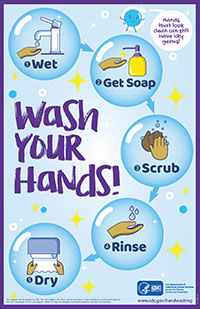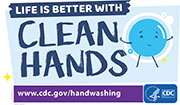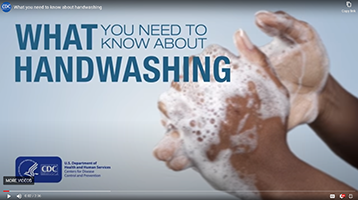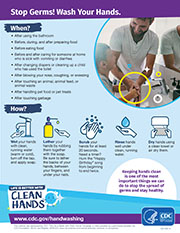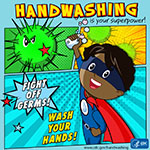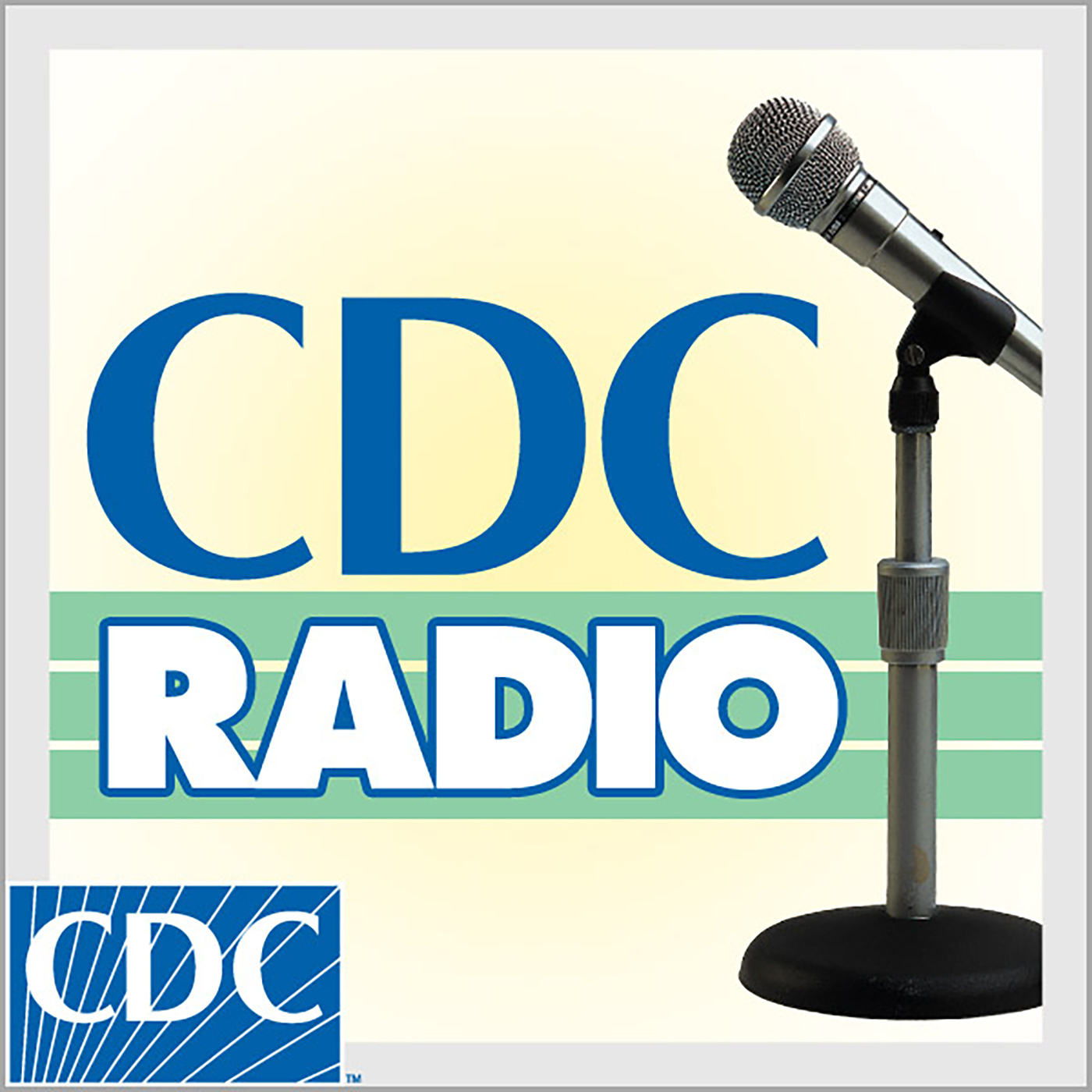ARCHIVED WEBPAGE: This web page is available for historical purposes. CDC is no longer updating this web page and it may not reflect CDC's current COVID-19 guidance. For the latest information, visit CDC's COVID-19 home page.
Aquatics FAQs
Recommendations for Fully Vaccinated People
COVID-19 Homepage
Cleaning, Disinfection, and Hand Hygiene in Schools – a Toolkit for School Administrators
A Toolkit for School Administrators
About this toolkit
Reducing the risk of exposure to SARS-CoV-2, the virus that causes COVID-19, by cleaning and disinfection is an integral part of opening schools that will require careful planning.
This toolkit is intended to aid school administrators as they consider how to protect the health, safety, and wellbeing of students, teachers, other school staff, families, and communities and prepare for educating students this fall.
School administrators are individuals who oversee the daily operations of K-12 schools, and may include school district superintendents, school principals, and assistant principals.
Cleaning and disinfecting your school will require you to:
- Develop your plan
- Implement your plan
- Maintain and revise your plan
Recommendations are based on CDC’s current knowledge of COVID-19 in the United States. CDC will continue to monitor COVID-19 activity and update toolkit as needed. This toolkit is meant to supplement—not replace—any state, local, territorial, or tribal health and safety laws, rules, and/or regulations with which schools must comply.
Reducing the Spread of Germs at Schools
Cleaning and promoting hand hygiene are important everyday actions schools can take to slow the spread of COVID-19 and other infectious diseases and protect students and staff.
Cleaning with products containing soap or detergent reduces germs on surfaces and objects by removing contaminants and may also weaken or damage some of the virus particles, which decreases risk of infection from surfaces. Cleaning high touch surfaces and shared objects once a day is usually enough to sufficiently remove virus that may be on surfaces unless someone with confirmed or suspected COVID-19 has been in your school. For more information on cleaning and disinfecting schools, see Cleaning and Disinfecting Your Facility.
Disinfecting (using disinfectants on U.S. Environmental Protection Agency (EPA)’s List Nexternal icon) removes any remaining germs on surfaces, which further reduces any risk of spreading infection.
Clean more frequently or clean AND disinfect surfaces and objects if certain conditions apply
- High transmission of COVID-19 in your community
- Low number of people wearing masks or improper mask usage
- Infrequent hand hygiene
- The space is occupied by people at increased risk for severe illness from COVID-19
When Someone is Sick
If someone in your school is sick or someone who has COVID-19 has been in your school in the last 24 hours, clean and disinfect your facility. For more information on cleaning and disinfecting safely, see Cleaning and Disinfecting Your Facility.
Use Disinfectants Safely
Always read and follow the directions on how to use and store cleaning and disinfecting products. Disinfection products should not be used by children or near children. Ventilate the space when using these products to prevent children from inhaling toxic vapor.
Consider ventilation system upgrades or improvements and other steps to increase the delivery of clean air and dilute potential contaminants in the building. Learn More.
Always follow standard practices and appropriate regulations specific to your school for minimum standards for cleaning and disinfection. For more information on cleaning various surfaces and other cleaning guidelines, see Cleaning and Disinfecting Your Facility.
Cleaning physically removes germs, dirt, and impurities from surfaces or objects by using soap (or detergent) and water.
This process does not necessarily kill germs, but by removing them, it lowers their numbers and the risk of spreading infection.
Disinfecting kills germs on surfaces or objects. Disinfecting works by using chemicals to kill germs on surfaces or objects.
This process does not necessarily clean dirty surfaces or remove germs, but by killing germs on a surface after cleaning, it can further lower the risk of spreading infection.
Note: It is important to clean indoor surfaces and objects routinely with soap (or detergent) and water. However, not every surface needs to be disinfected every time it is cleaned. Prioritize disinfecting surfaces that ill persons have touched and those that are routinely touched or shared between students.
Integrating Cleaning into the Daily Plan
Staff and Scheduling
- Plan with staff and teachers. Discuss obstacles to routine cleaning and ways to overcome those obstacles.
- Develop a schedule for routine cleaning. Modify your standard procedures to accommodate regularly cleaning at least once a day or as often as needed.
High touch Surfaces and Objects
- Clean high touch surfaces and objects (such as, door handles, sink handles, drinking fountains) within the school and on school transport vehicles (such as, buses) at least once a day or as often as needed (for example, when visibly dirty).
- Limit sharing of high touch objects that are difficult to regularly clean (such as, electronic devices, pens, pencils, books, games, art supplies, lab equipment).
- If certain conditions apply (such as, low mask usage or high community transmission), do not use difficult-to-clean shared objects for 72 hours.
- If items need to be reused within 24 hours they should be disinfected.
- Staff should wash hands after removing gloves or after handling used items or other objects near students who are unmasked.
- Regularly (at least once a day or as often as needed) clean surfaces using soap or detergent.
- If choosing to disinfect, ensure safe and correct use and storage of cleaning products, including storing products securely away from children.
- Use gloves when removing garbage bags or handling and disposing trash.
- Wash hands after removing gloves.
Soiled Surfaces
- Immediately clean surfaces and objects that are visibly soiled.
- Use soap or detergent to clean these surfaces or objects.
- If choosing to disinfect, dirty surfaces should be cleaned before disinfection.
- If surfaces or objects are soiled with body fluids or blood, use gloves and other standard precautions to avoid coming into contact with the fluid.
- Contain and remove the spill, and then clean and disinfect the surface.
Additional key resources:
- CDC’s Cleaning and Disinfection for Community Facilities Recommendations
- For more information about cleaning and disinfecting school buses or other transport vehicles, read CDC’s guidance for bus transit operators
- Glossary of Key Terms: Close Contact
- How to clean and disinfect if someone is sick
- Reopening Guidance for Cleaning and Disinfecting Public Spaces, Workplaces, Businesses, Schools, and Homes
- EPA List of disinfectants for use against the virus that causes COVID-19external icon
Hand hygiene: promoting it in your school
The best way to prevent COVID-19 is to avoid being exposed to the virus that causes COVID-19, which is thought to spread mainly from person to person. Another key preventive action you can take is to regularly clean hands. Cleaning hands at key times with soap and water for at least 20 seconds or using an alcohol-based hand sanitizer with at least 60% alcohol if soap and water is not readily available is one of the most important steps a person can take to avoid getting sick. This helps prevent a variety of infections because:
- People frequently touch their eyes, nose, and mouth without even realizing it. Germs can get into the body through the mouth, nose, and eyes and make us sick.
- Germs from unwashed hands can be transferred to other objects, like handrails, tabletops, or keyboards, and then be transferred to another person’s hands.
- Removing germs through handwashing therefore helps prevent diarrhea and respiratory infections and may even help prevent skin and eye infections.
Teaching people about handwashing helps them and their communities stay healthy. Handwashing can reduce respiratory illnesses, like colds, in the general population by up to 21%. Additionally, school-based programs promoting handwashing and hand hygiene can result in less gastrointestinal and respiratory illnesses and fewer missed school days.
For more information, see CDC’s Handwashing: Clean Hands Save Lives website.
Establishing a culture of hand hygiene
- Teach and reinforce handwashing with soap and water for at least 20 seconds and increase monitoring to ensure adherence among teachers, students, and staff.
- Build time into daily routines for students and staff to wash hands, especially at key times like after bathroom breaks, before lunch, or after playing outside. Take into consideration any additional time students or staff may need to wash their hands while social distancing.
- Consider making hand sanitizers with at least 60% alcohol available for teachers, staff, and students. Hand sanitizers can be placed near frequently touched surfaces (e.g., water fountains, doors, shared equipment) and areas where soap and water are not readily available (e.g., cafeterias, classrooms, gyms). Supervise young children under the age of 6 when they use hand sanitizer to prevent swallowing alcohol or contact with eyes.
- Promote hand hygiene throughout the school by placing visual cues such as handwashing posters, stickers, and other materials in highly visible areas.
- Download and print materials
- Order handwashing materials from CDC for free using CDC-INFO on Demand
Using hand sanitizers to reduce germs on hands
Use hand sanitizer when soap and water are not available
CDC recommends washing hands with soap and water because handwashing reduces the amounts of all types of germs and chemicals on hands. But if soap and water are not available, using a hand sanitizer with at least 60% alcohol can help you avoid getting sick and spreading germs to others. For school nutrition professionals and volunteers working in meal preparation and/or distribution at a school/school district site or other public settings, hand sanitizer is not a substitute for cleaning hands with soap and water.
When using hand sanitizer, apply the product to the palm of one hand (read the label to learn the correct amount) and rub the product all over the surfaces of your hands until your hands are dry.
Soap and water remove all types of germs from hands, while sanitizer acts by killing certain germs on the skin. Although alcohol-based hand sanitizers can quickly reduce the number of germs in many situations, they should be used in the right situations.
Hand sanitizers are less effective than handwashing in some situations
- Alcohol-based hand sanitizers kill SARS-CoV-2 when used correctly. However, hand sanitizers do not eliminate all types of germs, including some germs that cause diarrhea. Always wash hands with soap and water after using the toilet and after handling trash.
- Hand sanitizers may not be as effective when hands are visibly dirty or greasy. Hands are often dirty or greasy after activities like eating or playing outside.
- Hand sanitizers might not remove harmful chemicals, like pesticides and heavy metals, from hands.
Swallowing alcohol-based hand sanitizers can cause alcohol poisoning. In fact, calls to US poison centers for alcohol-based hand sanitizers increased by 36% from 2019 to 2020.
Prevent accidental poisoning
Hand sanitizers should be stored up, away, and out of sight of children and should be used with adult supervision for children under six years of age.
Get help in case of poisoning
- Call the poison control center, 1-800-222-1222, if you think a child has been poisoned but they are awake and alert; the center can be reached 24 hours a day, 7 days a week.
- Call 911 if you have a poison emergency or a child has collapsed or is not breathing.
Handwashing Resources
Find a variety of resources to help you promote handwashing in schools and at home.
Suggested uses
- Post in staff bathrooms, cafeteria kitchens, and communal areas such as teachers’ lounges, if open.
- Post in student bathrooms and locker rooms.
- Post near classroom sinks.
- Distribute to parents, guardians, and caregivers in electronic or print form and encourage them to post near their sinks at home.
Available in
English | Spanish | French | Arabic | Bengali | Chinese | Portuguese | Urdu | Haitian Creole
Suggested uses
- Use stickers for classroom rewards.
- Adhere clings to mirrors in school bathrooms or classroom windows.
- Share with parents to print and use at home.
Available in
English | Spanish
Suggested uses
- Play on school TVs or screens.
- Distribute to staff to incorporate into lessons about handwashing.
- Distribute to parents to use at home with kids.
Available in
English | Spanish
Suggested uses
- Distribute to staff, parents, and students.
- Post near hand sanitizer dispensers.
- Distribute to parents, guardians, and caregivers in electronic or print form and encourage them to post near their sinks at home.
Available in
English | Spanish | French | Haitian Creole
Suggested uses
- Use CDC’s graphics and messages when drafting communications about handwashing for staff, parents, or students.
- Promote handwashing on your school or district’s social media accounts.
Available in
English | Spanish
Suggested uses
- Play during school announcements.
- Distribute to staff to incorporate into lessons about handwashing.
Available in
- English
